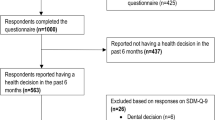Abstract
The Q method, combining qualitative and quantitative methods, refers to the qualitative analysis of Q-sorts based on quantitative techniques. It is used to research individual subjective experience, analyzing consensus and divergence to identify and categorize subjects’ viewpoints. The sorting process is completely performed by the subjects, independent of study researchers. The Q method in medical research has been applied in many fields, including nursing care, clinical studies, doctor and patient’s perceptions, health evaluation and decision making. The authors used the Q method to research Chinese medicine (CM) group decision making, exploring its practical feasibility in this important field. Four primary domains are addressed: (1) integration of expert opinion; (2) expert classification; (3) ascertaining the entire viewpoint orientation of a certain type of expert; and (4) comparison of expert opinion using an additional perspective. The essence of the Q method caters to the CM thinking model and should be introduced into CM and explored more deeply.
Similar content being viewed by others
References
Kuhne N, Abernot Y, Camus D. Q-sort, a useful research method in care in cases of psychiatric nursing of the aged. Rech Soins Infirm 2008;95:46–56.
Yeun E. Attitudes of elderly Korean patients toward death and dying: an application of Q-methodology. Int J Nurs Study 2005;42:871–880.
Boffa DP, Pawola LM. Identification and conceptualization of nurse super users. J Health Inf Manag 2006;20(4):60–68.
Scharf L, Caley L. Patients’, nurses’, and physicians’ perceptions of nurses’ caring behaviors. Nurs Connect 1993;6:3–12.
Risdon A, Eccleston C, Crombez G, McCracken L. How can we learn to live with pain? A Q-methodological analysis of the diverse understandings of acceptance of chronic pain. Soc Sci Med 2003;56:375–386.
Goto K, Tiffany J, Pelto G, Pelletier D. Use of Q method to analyze divergent perspectives on participatory action research as a strategy for HIV/AIDS prevention among Caribbean youth. AIDS Educ Prev 2008;20:301–311.
Prateepko T, Chongsuvivatwong V. Patterns of perception toward influenza pandemic among the front-line responsible health personnel in southern Thailand: a Q method approach. BMC Public Health 2009;28:161.
Farrimond H, Joffe H, Stenner P. A Q-methodological study of smoking identities. Psychol Health 2010;22(3):1–20.
van Exel NJ, de Graaf G, Brouwer WB. “Everyone dies, so you might as well have fun!” Attitudes of Dutch youths about their health lifestyle. Soc Sci Med 2006;63:2628–2639.
Tielen M, van Staa AL, Jedeloo S, van Exel NJ, Weimar W. Q-methodology to identify young adult renal transplant recipients at risk for non-adherence. Transplantation 2008;85:700–706.
Bullington P, Pawola L, Walker R, Valenta A, Briars L, John E. Identification of medication non-adherence factors in adolescent transplant patients: the patient’s viewpoint. Pediatr Transplant 2007;11:914–921.
Samuels JG, Fetzer S. Development of the Samuels Scale to rate pain management documentation. Pain Manag Nurs 2008;9:166–170.
Lai JS, Kupst MJ, Cella D, Brown SR, Peterman A, Goldman S. Using Q-methodology to understand perceived fatigue reported by adolescents with cancer. Psychooncology 2007;16:437–447.
Dennis KE, Tomoyasu N, McCrone SH, Goldberg AP, Bunyard L, Qi BB. Self-efficacy targeted treatments for weight loss in postmenopausal women. Sch Inq Nurs Pract 2001;15:259–276.
Webler T, Tuler S, Krueger R. What is a good public participation process? Five perspectives from the public. Environ Manag 2001;27:435–450.
Wong W, Eiser AR, Mrtek RG, Heckerling PS. Byperson factor analysis in clinical ethical decision making: Q method in end-of-life care decisions. Am J Bioeth 2004;4(3):W8–W22.
Morecroft C, Cantrill J, Tully MP. Individual patient’s preferences for hypertension management: a Q-methodological approach. Patient Educ Couns 2006;61:354–362.
Morecroft C, Cantrill J, Tully M. Patients’ and general practitioners’ views of what constitutes appropriate hypertension management. J Health Serv Res Policy 2005;10(2):91–96.
Ryan CJ, Zerwic JJ. Knowledge of symptom clusters among adults at risk for acute myocardial infarction. Nurs Res 2004;53:363–369.
Jedeloo S, van Staa A, Latour JM, van Exel NJ. Preferences for health care and self-management among Dutch adolescents with chronic conditions: a Q-methodological investigation. Int J Nurs Study 2010;47:593–603.
Dudley R, Siitarinen J, James I, Dodgson G. What do people with psychosis think caused their psychosis? A Q method study. Behav Cogn Psychother 2009;37:11–24.
Watkins RE, Plant AJ. Clinic staff perceptions of tuberculosis treatment delivery in Bali. Patient Educ Couns 2005;56:340–348.
Baker RM. Economic rat ional i ty and heal th and lifestyle choices for people with diabetes. Soc Sci Med 2006;63:2341–2353.
Gallagher K, Porock D. The use of interviews in Q method: card content analysis. Nurs Res 2010;59:295–300.
Cross RM. Exploring attitudes: the case for Q method. Health Educ Res 2005;20:206–213.
Akhtar-Danesh N, Baumann A, Cordingley L. Q-methodology in nursing research: a promising method for the study of subjectivity. West J Nurs Res 2008;30:759–773.
Barker JH. Q-methodology: an alternative approach to research in nurse education. Nurs Educ Today 2008;28:917–925.
Guzman J, Hayden J, Furlan AD, Cassidy JD, Loisel P, Flannery J, et al. Key factors in back disability prevention: a consensus panel on their impact and modifiability. Spine (Phila Pa 1976) 2007;32:807–815.
Lister M, Gardner D. Engaging hard to engage clients: a Q methodological study involving clinical psychologists. Psychol Psychother 2006;79:419–443.
Herron-Marx S, Williams A, Hicks C. A Q method study of women’s experience of enduring postnatal perineal and pelvic floor morbidity. Midwifery 2007;23:322–334.
Liu MY, Peng J, Jiang M, Lu AP. Preliminary research on application of Q method in studying experiences of Chinese medicine. Chin J Integr Tradit West Med (Chin) 2010;30:1101–1104.
Author information
Authors and Affiliations
Corresponding authors
Additional information
Supported by the Fund from China Academy of Chinese Medical Sciences (No. Z02110)
Rights and permissions
About this article
Cite this article
Liu, My., Li, Y., Lu, Ap. et al. Feasibility analysis of the value of Q method in the classification and understanding of expert experience. Chin. J. Integr. Med. 19, 869–873 (2013). https://doi.org/10.1007/s11655-012-1174-z
Received:
Published:
Issue Date:
DOI: https://doi.org/10.1007/s11655-012-1174-z




